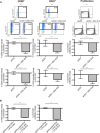Immune evasion mediated by PD-L1 on glioblastoma-derived extracellular vesicles
- PMID: 29532035
- PMCID: PMC5842038
- DOI: 10.1126/sciadv.aar2766
Immune evasion mediated by PD-L1 on glioblastoma-derived extracellular vesicles
Abstract
Binding of programmed death ligand-1 (PD-L1) to programmed cell death protein-1 (PD1) leads to cancer immune evasion via inhibition of T cell function. One of the defining characteristics of glioblastoma, a universally fatal brain cancer, is its profound local and systemic immunosuppression. Glioblastoma has also been shown to generate extracellular vesicles (EVs), which may play an important role in tumor progression. We thus hypothesized that glioblastoma EVs may be important mediators of immunosuppression and that PD-L1 could play a role. We show that glioblastoma EVs block T cell activation and proliferation in response to T cell receptor stimulation. PD-L1 was expressed on the surface of some, but not of all, glioblastoma-derived EVs, with the potential to directly bind to PD1. An anti-PD1 receptor blocking antibody significantly reversed the EV-mediated blockade of T cell activation but only when PD-L1 was present on EVs. When glioblastoma PD-L1 was up-regulated by IFN-γ, EVs also showed some PD-L1-dependent inhibition of T cell activation. PD-L1 expression correlated with the mesenchymal transcriptome profile and was anatomically localized in the perinecrotic and pseudopalisading niche of human glioblastoma specimens. PD-L1 DNA was present in circulating EVs from glioblastoma patients where it correlated with tumor volumes of up to 60 cm3. These results suggest that PD-L1 on EVs may be another mechanism for glioblastoma to suppress antitumor immunity and support the potential of EVs as biomarkers in tumor patients.
Figures






Similar articles
-
Extracellular vesicles containing PD-L1 contribute to CD8+ T-cell immune suppression and predict poor outcomes in small cell lung cancer.Clin Exp Immunol. 2022 May 12;207(3):307-317. doi: 10.1093/cei/uxac006. Clin Exp Immunol. 2022. PMID: 35553630 Free PMC article.
-
Sigma1 inhibitor suppression of adaptive immune resistance mechanisms mediated by cancer cell derived extracellular vesicles.Cancer Biol Ther. 2025 Dec;26(1):2455722. doi: 10.1080/15384047.2025.2455722. Epub 2025 Jan 26. Cancer Biol Ther. 2025. PMID: 39863992 Free PMC article.
-
Circulating extracellular vesicles expressing PD1 and PD-L1 predict response and mediate resistance to checkpoint inhibitors immunotherapy in metastatic melanoma.Mol Cancer. 2022 Jan 18;21(1):20. doi: 10.1186/s12943-021-01490-9. Mol Cancer. 2022. PMID: 35042524 Free PMC article.
-
Immune Escape Mediated by Exosomal PD-L1 in Cancer.Adv Biosyst. 2020 Dec;4(12):e2000017. doi: 10.1002/adbi.202000017. Epub 2020 May 7. Adv Biosyst. 2020. PMID: 32383351 Free PMC article. Review.
-
Extracellular vesicle-mediated immunoregulation in cancer.Int J Hematol. 2023 May;117(5):640-646. doi: 10.1007/s12185-022-03436-3. Epub 2022 Aug 11. Int J Hematol. 2023. PMID: 35951282 Review.
Cited by
-
Molecular Heterogeneity and Immunosuppressive Microenvironment in Glioblastoma.Front Immunol. 2020 Jul 17;11:1402. doi: 10.3389/fimmu.2020.01402. eCollection 2020. Front Immunol. 2020. PMID: 32765498 Free PMC article. Review.
-
Cytomegalovirus infection of glioblastoma cells leads to NF-κB dependent upregulation of the c-MET oncogenic tyrosine kinase.Cancer Lett. 2021 Aug 10;513:26-35. doi: 10.1016/j.canlet.2021.05.005. Epub 2021 May 12. Cancer Lett. 2021. PMID: 33989707 Free PMC article.
-
Extracellular Vesicles and Their Role in the Spatial and Temporal Expansion of Tumor-Immune Interactions.Int J Mol Sci. 2021 Mar 25;22(7):3374. doi: 10.3390/ijms22073374. Int J Mol Sci. 2021. PMID: 33806053 Free PMC article. Review.
-
Secreted Extracellular Vesicle Molecular Cargo as a Novel Liquid Biopsy Diagnostics of Central Nervous System Diseases.Int J Mol Sci. 2021 Mar 23;22(6):3267. doi: 10.3390/ijms22063267. Int J Mol Sci. 2021. PMID: 33806874 Free PMC article. Review.
-
Decoding the secret of extracellular vesicles in the immune tumor microenvironment of the glioblastoma: on the border of kingdoms.Front Immunol. 2024 Aug 29;15:1423232. doi: 10.3389/fimmu.2024.1423232. eCollection 2024. Front Immunol. 2024. PMID: 39267734 Free PMC article. Review.
References
-
- Stupp R., Mason W. P., van den Bent M. J., Weller M., Fisher B., Taphoorn M. J. B., Belanger K., Brandes A. A., Marosi C., Bogdahn U., Curschmann J., Janzer R. C., Ludwin S. K., Gorlia T., Allgeier A., Lacombe D., Cairncross J. G., Eisenhauer E., Mirimanoff R. O. European Organisation for Research and Treatment of Cancer Brain Tumor and Radiotherapy Groups; National Cancer Institute of Canada Clinical Trials Group , Radiotherapy plus concomitant and adjuvant temozolomide for glioblastoma. N. Engl. J. Med. 352, 987–996 (2005). - PubMed
-
- Mahoney K. M., Rennert P. D., Freeman G. J., Combination cancer immunotherapy and new immunomodulatory targets. Nat. Rev. Drug Discov. 14, 561–584 (2015). - PubMed
-
- Kmiecik J., Poli A., Brons N. H. C., Waha A., Eide G. E., Enger P. Ø., Zimmer J., Chekenya M., Elevated CD3+ and CD8+ tumor-infiltrating immune cells correlate with prolonged survival in glioblastoma patients despite integrated immunosuppressive mechanisms in the tumor microenvironment and at the systemic level. J. Neuroimmunol. 264, 71–83 (2013). - PubMed
Publication types
MeSH terms
Substances
Grants and funding
LinkOut - more resources
Full Text Sources
Other Literature Sources
Medical
Research Materials

